Have you seen your indoor plants with leaves turning yellow? This is a common problem many plant owners face. But what’s causing it, and how can you fix it? By understanding the reasons, you can help your plants get back to their best.
There are many reasons why leaves turn yellow, like bad watering or stress from the environment. In this article, we’ll look at the main causes and how to fix them. You’ll learn how to keep your indoor plants healthy and green again.
Overwatering or Underwatering: A Leading Culprit
Watering issues are a big reason why indoor plants turn yellow. Overwatering and underwatering can cause leaf discoloration and other problems. Knowing the signs of these issues and fixing them can help your plants recover.
Signs of Over or Underwatering
Overwatered plants show yellow lower leaves, mushy stems, and wet soil. Underwatered plants have yellow leaves at the tips and edges, and they wilt.
Correcting Watering Issues
To fix watering problems, check the soil moisture first. If the soil is dry, water the plant until it drains from the bottom. If it’s wet and soggy, wait a bit before watering again. You might need to repot the plant in a container with better drainage to avoid overwatering.
It’s important to water your plant regularly, but not too much or too little. Test the soil moisture often and adjust your watering based on what you find. This way, you can avoid the mistakes of overwatering or underwatering.
https://www.youtube.com/watch?v=BopuNFAhfrs
“Proper watering is essential for the overall health and vitality of your indoor plants.”
Age and Natural Leaf Shedding
As your indoor plants get older, it’s normal for the lower leaves to turn yellow and fall off. This is part of the plant’s life cycle, as it uses energy for new growth. Don’t worry if you see some leaves dropping – it means your plant is doing well.
Regular leaf drop shows your indoor plants are getting the care they need. As plants age, they shed their oldest leaves to focus on new, healthy ones. This normal leaf shedding is a sign of a plant’s aging houseplants and leaf drop lifecycle.
- Older, lower leaves are the first to turn yellow and fall off as part of the plant’s natural growth cycle.
- Shedding a few leaves is normal and helps the plant direct energy to new, healthy growth.
- Excessive or premature leaf drop may indicate an underlying issue, so keep an eye on the pattern and extent of the leaf loss.
If the leaf shedding seems too much or is happening higher up, it could mean a problem. But a bit of normal leaf shedding on your aging houseplants is just part of the leaf drop lifecycle. No need to worry!
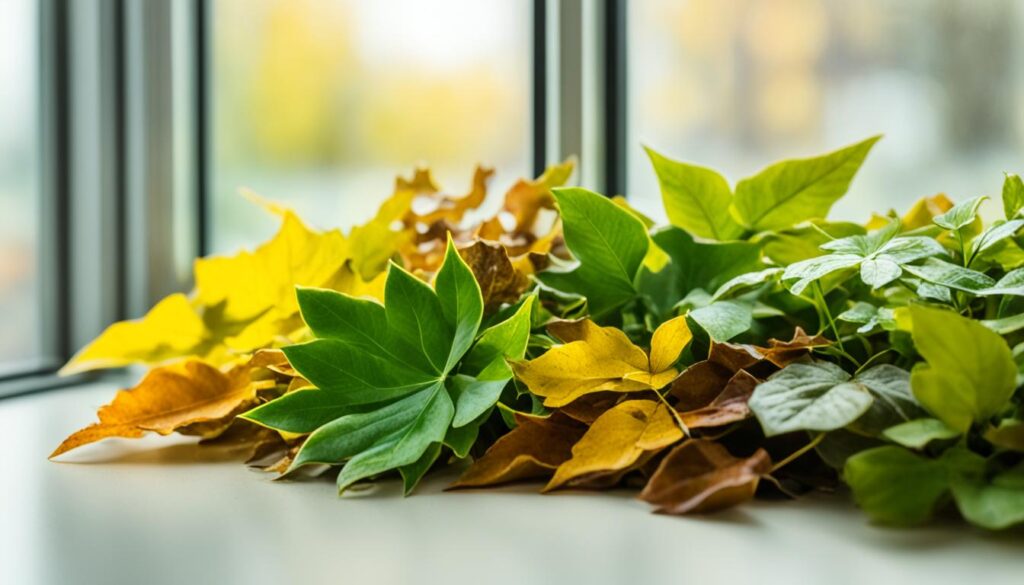
“Regularly shedding a few older leaves is a normal part of a plant’s growth cycle as it directs resources to new foliage.”
Environmental Stressors: Cold Drafts and Insufficient Light
The environment where your indoor plants live is key to their health. Cold drafts and not enough light are two common issues that can make leaves turn yellow.
Tropical and subtropical plants, often found indoors, don’t like sudden temperature changes. Cold air from vents or drafty windows can make them lose leaves. This is their way of protecting themselves, but it makes them look yellow. To fix this, move your plant away from cold spots.
Not enough light can also turn leaves yellow, especially if the plant is not facing the light. If your plant is too far from a window or lacks extra light, it may start to look unhealthy. Move it closer to a sunny window or give it a grow light.
“Proper environmental conditions are essential for the long-term health and vibrant appearance of your indoor plants.”
By fixing these issues, your houseplants can stay healthy and green. Paying attention to their environment helps prevent yellow leaves. This keeps your indoor space looking great.
Nutrient Deficiencies and Soil Issues
If your indoor plants have yellow leaves, it could be due to nutrient lack or soil pH problems. Knowing about common nutrient shortages and how soil pH impacts nutrient availability can help you fix your plants. This will bring them back to their green and healthy state.
Common Nutrient Deficiency Patterns
Nutrient shortages show up in different ways on your indoor plants’ leaves. For example, a nitrogen deficiency makes older leaves turn yellow. Potassium deficiency shows as yellow edges on leaves, and magnesium deficiency causes yellowing between the leaf veins.
To fix these nutrient issues, you might need to change your indoor plant’s fertilizer. Picking the right fertilizer and using it correctly can solve the deficiency. This will help your plants grow well again.
Soil pH and Nutrient Availability
The soil’s pH is key to which nutrients your indoor plants can take in. Most indoor plants do best in soil with a pH between 6.0 and 7.0. If the pH is off, some nutrients won’t be available, causing yellow leaves.
Doing a simple soil test can show if your potting mix’s pH is off. Then, you can adjust the soil to get the pH right. This ensures your plants can take in the nutrients they need for good health.
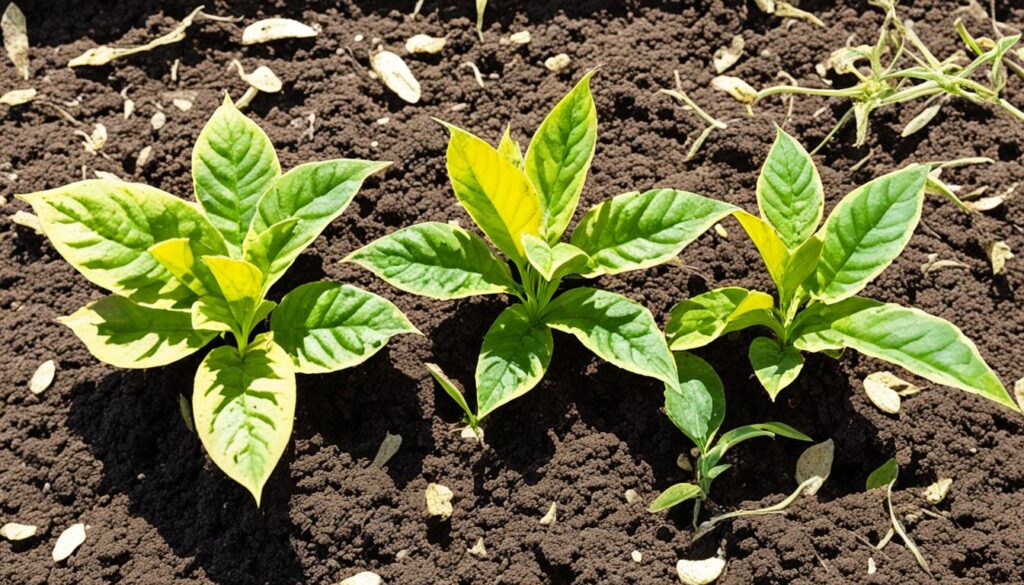
“Maintaining the right soil pH is crucial for ensuring your indoor plants can access the essential nutrients they need to thrive.”
Pests, Diseases, and Other Plant Ailments
Your indoor plants might face pests, diseases, and stress that turn their leaves yellow. Aphids and spider mites, which suck sap, can harm the leaves. Fungal infections can cause yellow spots to spread on the leaves.
Other issues like repotting stress, chemical exposure, or environmental stress can also turn leaves yellow. It’s important to find and fix the problem, whether it’s pests, diseases, or stress. This will help your plants get back to being green and healthy.
By watching closely and acting fast, you can keep your indoor plants healthy and full of life. With some care and attention, you can beat these problems and have the greenery you want.
FAQ
What are the common causes of yellowing leaves on indoor plants?
Yellowing leaves on indoor plants can come from watering problems, stress, nutrient lack, and pests or diseases.
How can I tell if my plant is over or underwatered?
Overwatered plants show yellow lower leaves, mushy stems, and wet soil. Underwatered plants have yellow tips and edges, and they wilt.
How do I fix watering problems with my indoor plants?
Check the soil moisture by sticking your finger into the potting mix. If it’s dry, water until it drains from the bottom. If it’s wet, wait a bit before watering again. Sometimes, you need to repot in a better-draining container.
Is it normal for older leaves to turn yellow and drop off?
Yes, older leaves turning yellow and dropping off is normal. It’s part of the plant’s life cycle. This is okay if it only happens to the older leaves.
What environmental factors can lead to yellowing leaves on indoor plants?
Cold drafts and not enough light can make indoor plant leaves turn yellow. Moving the plant or adding more light can help.
How do nutrient deficiencies and soil pH affect indoor plant leaves?
Lack of nutrients like nitrogen, potassium, and magnesium can make leaves turn yellow. Soil pH that’s off can also cause nutrient problems and yellow leaves.
What other plant ailments can cause yellow leaves?
Pests, diseases, and stress from repotting or chemicals can also make leaves turn yellow. Fixing the problem is key to getting healthy green leaves back.


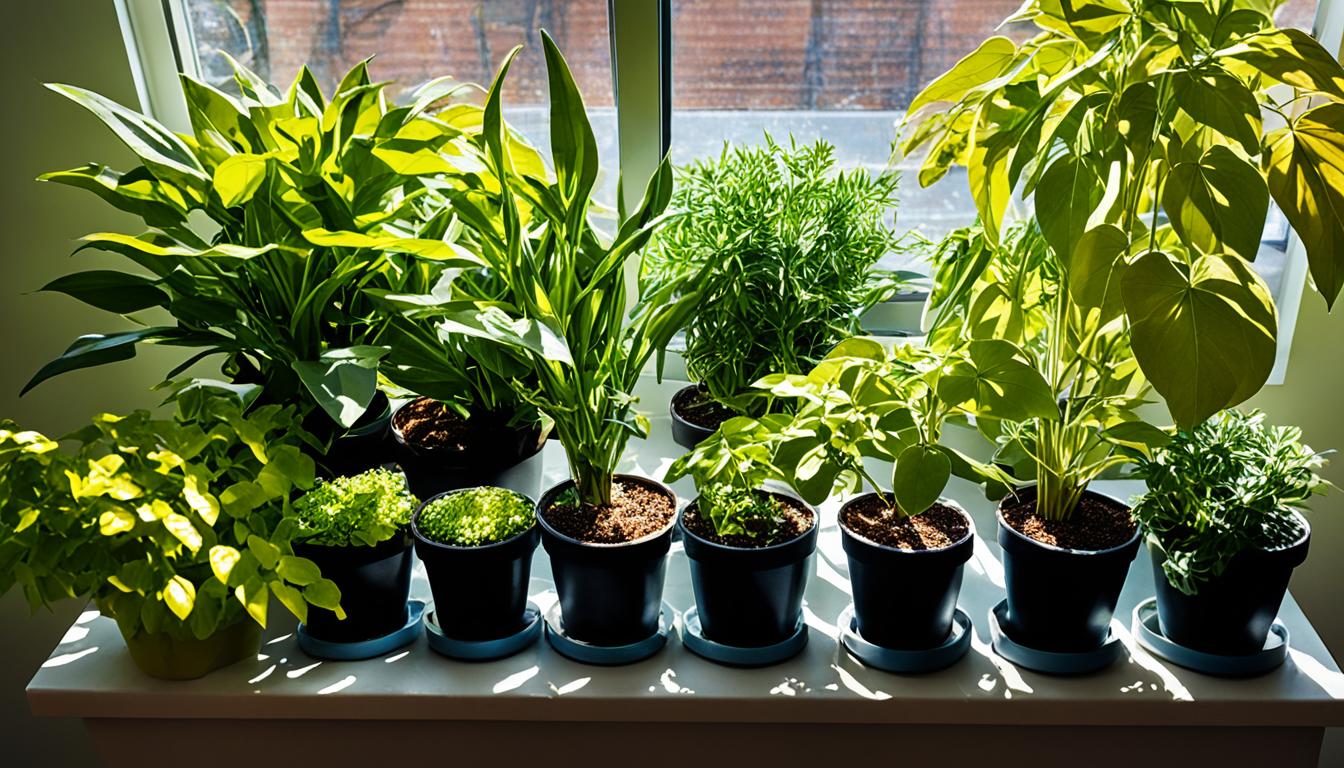
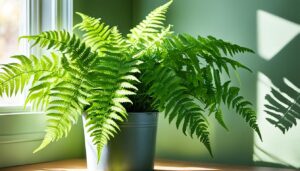
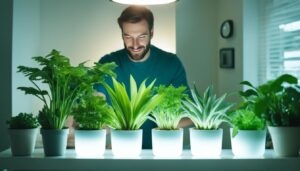
Pingback: Prayer Plant, A Unique, Non-Toxic Houseplant with Beautiful Leaf Movements